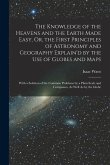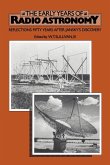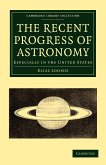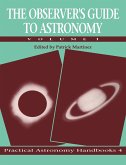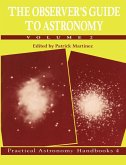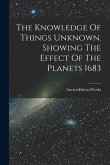- Broschiertes Buch
- Merkliste
- Auf die Merkliste
- Bewerten Bewerten
- Teilen
- Produkt teilen
- Produkterinnerung
- Produkterinnerung
This 1898 work is a comprehensive survey of current astronomical knowledge, written by experts and aimed at the general audience.
Andere Kunden interessierten sich auch für
![The Knowledge of the Heavens and the Earth Made Easy, Or, the First Principles of Astronomy and Geography Explain'd by the Use of Globes and Maps: Wit The Knowledge of the Heavens and the Earth Made Easy, Or, the First Principles of Astronomy and Geography Explain'd by the Use of Globes and Maps: Wit]() Isaac WattsThe Knowledge of the Heavens and the Earth Made Easy, Or, the First Principles of Astronomy and Geography Explain'd by the Use of Globes and Maps: Wit25,99 €
Isaac WattsThe Knowledge of the Heavens and the Earth Made Easy, Or, the First Principles of Astronomy and Geography Explain'd by the Use of Globes and Maps: Wit25,99 €![The Early Years of Radio Astronomy The Early Years of Radio Astronomy]() W. T. SullivanThe Early Years of Radio Astronomy64,99 €
W. T. SullivanThe Early Years of Radio Astronomy64,99 €![The Recent Progress of Astronomy The Recent Progress of Astronomy]() Elias LoomisThe Recent Progress of Astronomy50,99 €
Elias LoomisThe Recent Progress of Astronomy50,99 €![The Observer's Guide to Astronomy The Observer's Guide to Astronomy]() Patrick Martinez (ed.)The Observer's Guide to Astronomy119,99 €
Patrick Martinez (ed.)The Observer's Guide to Astronomy119,99 €![The Observer's Guide to Astronomy The Observer's Guide to Astronomy]() Patrick Martinez (ed.)The Observer's Guide to Astronomy95,99 €
Patrick Martinez (ed.)The Observer's Guide to Astronomy95,99 €![The Castle of Knowledge The Castle of Knowledge]() The Castle of Knowledge26,99 €
The Castle of Knowledge26,99 €![The Knowledge Of Things Unknown. Showing The Effect Of The Planets 1683 The Knowledge Of Things Unknown. Showing The Effect Of The Planets 1683]() The Knowledge Of Things Unknown. Showing The Effect Of The Planets 168318,99 €
The Knowledge Of Things Unknown. Showing The Effect Of The Planets 168318,99 €-
-
-
This 1898 work is a comprehensive survey of current astronomical knowledge, written by experts and aimed at the general audience.
Hinweis: Dieser Artikel kann nur an eine deutsche Lieferadresse ausgeliefert werden.
Hinweis: Dieser Artikel kann nur an eine deutsche Lieferadresse ausgeliefert werden.
Produktdetails
- Produktdetails
- Verlag: Cambridge University Press
- Seitenzahl: 602
- Erscheinungstermin: 22. Oktober 2010
- Englisch
- Abmessung: 216mm x 140mm x 35mm
- Gewicht: 838g
- ISBN-13: 9781108023887
- ISBN-10: 1108023886
- Artikelnr.: 32942283
- Herstellerkennzeichnung
- Libri GmbH
- Europaallee 1
- 36244 Bad Hersfeld
- gpsr@libri.de
- Verlag: Cambridge University Press
- Seitenzahl: 602
- Erscheinungstermin: 22. Oktober 2010
- Englisch
- Abmessung: 216mm x 140mm x 35mm
- Gewicht: 838g
- ISBN-13: 9781108023887
- ISBN-10: 1108023886
- Artikelnr.: 32942283
- Herstellerkennzeichnung
- Libri GmbH
- Europaallee 1
- 36244 Bad Hersfeld
- gpsr@libri.de
Preface
Section I. History Agnes M. Clerke: 1. From Hipparchus to Laplace
2. A century of progress
Section II. Geometrical Astronomy and Astronomical Instruments A. Fowler: 1. The Earth and its rotation
2. The Earth's revolution round the Sun
3. How the positions of the heavenly bodies are defined
4. The Earth's orbit
5. Mean solar time
6. The movements of the Moon
7. Movements of planets, satellites, and comets
8. Eclipses and occultations
9. How to find our situation on the Earth
10. The exact size and shape of the earth
11. The distances and dimensions of the heavenly bodies
12. The masses of celestial bodies
13. Gravitational effects of Sun and moon upon the Earth
14. Instrumental measurement of angles and time
15. Telescopes
16. Instruments of precision
17. Astrophysical instruments
Section III. The Solar System Agnes M. Clerke: 1. The solar system as a whole
2. The Sun
3. The Sun's surroundings
4. The interior planets
5. The Earth and Moon
6. The planet Mars
7. The asteroids
8. The planet Jupiter
9. The Saturnian system
10. Uranus and Neptune
11. Famous comets
12. Nature and origin of comets
13. Meteorites and shooting stars
Section IV. The Sidereal Heavens J.E. Gore: 1. The stars and constellations
2. Double, multiple, and coloured stars
3. The distances and motions of the stars
4. Binary stars
5. Variable and temporary stars
6. Clusters and nebulae
7. The construction of the heavens
Index.
Section I. History Agnes M. Clerke: 1. From Hipparchus to Laplace
2. A century of progress
Section II. Geometrical Astronomy and Astronomical Instruments A. Fowler: 1. The Earth and its rotation
2. The Earth's revolution round the Sun
3. How the positions of the heavenly bodies are defined
4. The Earth's orbit
5. Mean solar time
6. The movements of the Moon
7. Movements of planets, satellites, and comets
8. Eclipses and occultations
9. How to find our situation on the Earth
10. The exact size and shape of the earth
11. The distances and dimensions of the heavenly bodies
12. The masses of celestial bodies
13. Gravitational effects of Sun and moon upon the Earth
14. Instrumental measurement of angles and time
15. Telescopes
16. Instruments of precision
17. Astrophysical instruments
Section III. The Solar System Agnes M. Clerke: 1. The solar system as a whole
2. The Sun
3. The Sun's surroundings
4. The interior planets
5. The Earth and Moon
6. The planet Mars
7. The asteroids
8. The planet Jupiter
9. The Saturnian system
10. Uranus and Neptune
11. Famous comets
12. Nature and origin of comets
13. Meteorites and shooting stars
Section IV. The Sidereal Heavens J.E. Gore: 1. The stars and constellations
2. Double, multiple, and coloured stars
3. The distances and motions of the stars
4. Binary stars
5. Variable and temporary stars
6. Clusters and nebulae
7. The construction of the heavens
Index.
Preface
Section I. History Agnes M. Clerke: 1. From Hipparchus to Laplace
2. A century of progress
Section II. Geometrical Astronomy and Astronomical Instruments A. Fowler: 1. The Earth and its rotation
2. The Earth's revolution round the Sun
3. How the positions of the heavenly bodies are defined
4. The Earth's orbit
5. Mean solar time
6. The movements of the Moon
7. Movements of planets, satellites, and comets
8. Eclipses and occultations
9. How to find our situation on the Earth
10. The exact size and shape of the earth
11. The distances and dimensions of the heavenly bodies
12. The masses of celestial bodies
13. Gravitational effects of Sun and moon upon the Earth
14. Instrumental measurement of angles and time
15. Telescopes
16. Instruments of precision
17. Astrophysical instruments
Section III. The Solar System Agnes M. Clerke: 1. The solar system as a whole
2. The Sun
3. The Sun's surroundings
4. The interior planets
5. The Earth and Moon
6. The planet Mars
7. The asteroids
8. The planet Jupiter
9. The Saturnian system
10. Uranus and Neptune
11. Famous comets
12. Nature and origin of comets
13. Meteorites and shooting stars
Section IV. The Sidereal Heavens J.E. Gore: 1. The stars and constellations
2. Double, multiple, and coloured stars
3. The distances and motions of the stars
4. Binary stars
5. Variable and temporary stars
6. Clusters and nebulae
7. The construction of the heavens
Index.
Section I. History Agnes M. Clerke: 1. From Hipparchus to Laplace
2. A century of progress
Section II. Geometrical Astronomy and Astronomical Instruments A. Fowler: 1. The Earth and its rotation
2. The Earth's revolution round the Sun
3. How the positions of the heavenly bodies are defined
4. The Earth's orbit
5. Mean solar time
6. The movements of the Moon
7. Movements of planets, satellites, and comets
8. Eclipses and occultations
9. How to find our situation on the Earth
10. The exact size and shape of the earth
11. The distances and dimensions of the heavenly bodies
12. The masses of celestial bodies
13. Gravitational effects of Sun and moon upon the Earth
14. Instrumental measurement of angles and time
15. Telescopes
16. Instruments of precision
17. Astrophysical instruments
Section III. The Solar System Agnes M. Clerke: 1. The solar system as a whole
2. The Sun
3. The Sun's surroundings
4. The interior planets
5. The Earth and Moon
6. The planet Mars
7. The asteroids
8. The planet Jupiter
9. The Saturnian system
10. Uranus and Neptune
11. Famous comets
12. Nature and origin of comets
13. Meteorites and shooting stars
Section IV. The Sidereal Heavens J.E. Gore: 1. The stars and constellations
2. Double, multiple, and coloured stars
3. The distances and motions of the stars
4. Binary stars
5. Variable and temporary stars
6. Clusters and nebulae
7. The construction of the heavens
Index.


